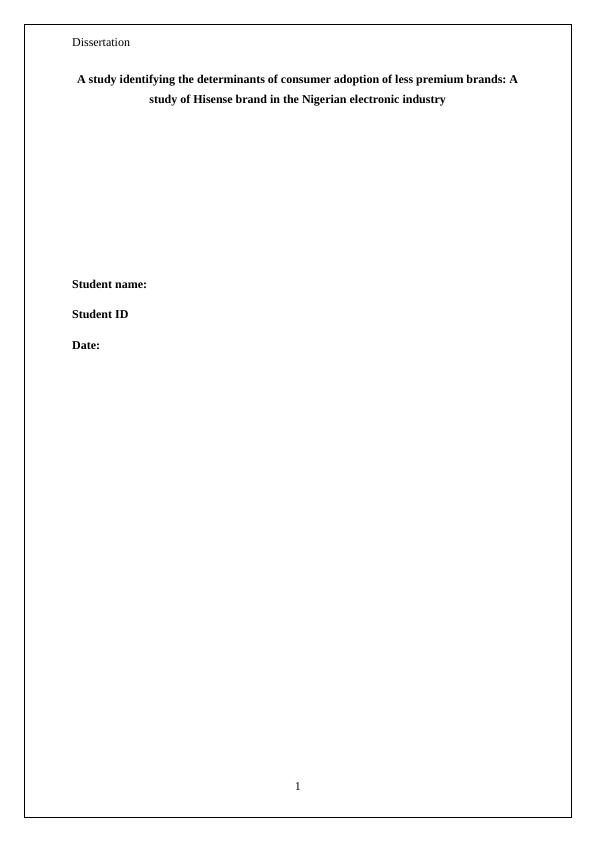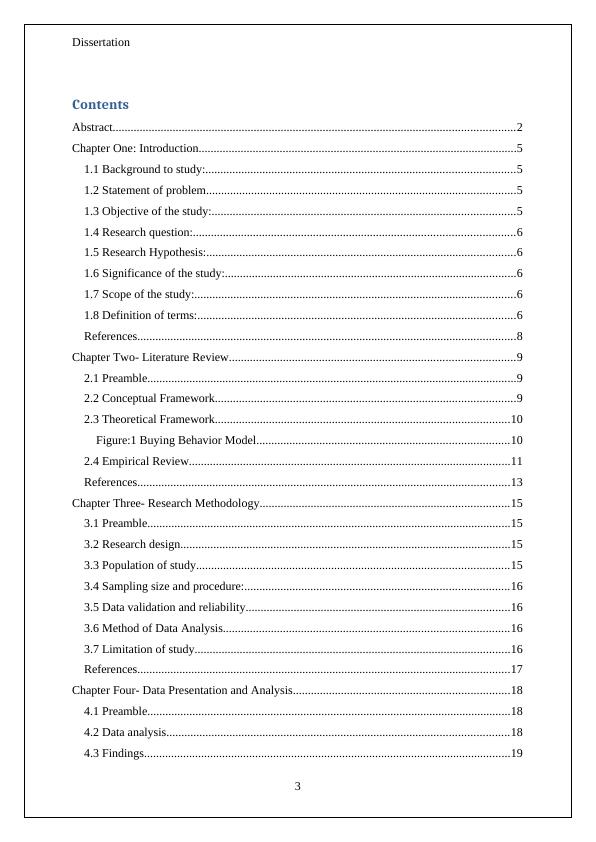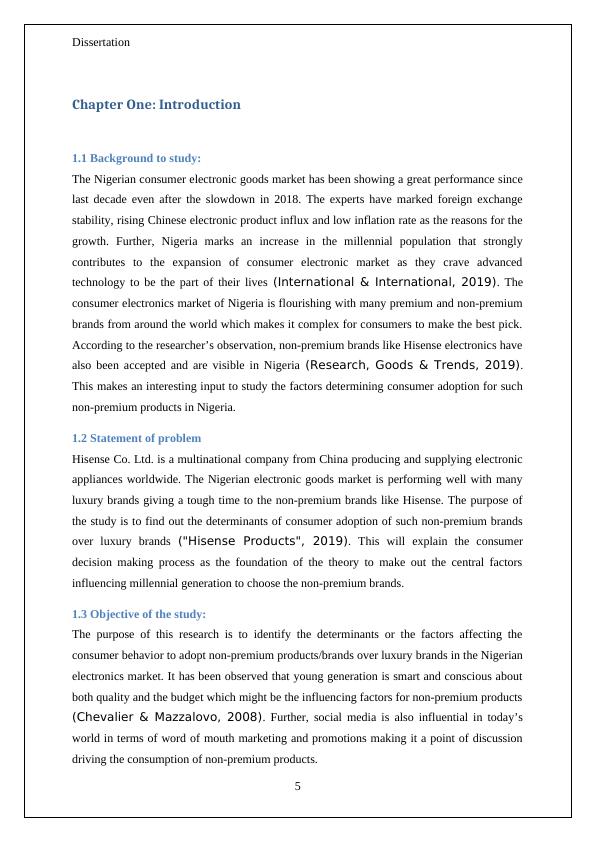Determinants of Consumer Adoption of Less Premium Brands in Nigerian Electronic Industry
Added on 2023-04-21
29 Pages5716 Words61 Views
Dissertation
A study identifying the determinants of consumer adoption of less premium brands: A
study of Hisense brand in the Nigerian electronic industry
Student name:
Student ID
Date:
1
A study identifying the determinants of consumer adoption of less premium brands: A
study of Hisense brand in the Nigerian electronic industry
Student name:
Student ID
Date:
1

Dissertation
Abstract
The Nigerian consumer electronic goods market has been showing a great performance since
last decade even after the slowdown in 2018. The experts have marked foreign exchange
stability, rising Chinese electronic product influx and low inflation rate as the reasons for the
growth. Further, Nigeria marks an increase in the millennial population that strongly
contributes to the expansion of consumer electronic market as they crave advanced
technology to be the part of their lives. Hisense Co. Ltd. is a multinational company from
China producing and supplying electronic appliances worldwide. The Nigerian electronic
goods market is performing well with many luxury brands giving a tough time to the non-
premium brands like Hisense. The purpose of the study is to find out the determinants of
consumer adoption of such non-premium brands over luxury brands. The researcher has
applied primary method of data collection to find out the major determinants of consumer
adoption for less premium products in Nigerian context.
2
Abstract
The Nigerian consumer electronic goods market has been showing a great performance since
last decade even after the slowdown in 2018. The experts have marked foreign exchange
stability, rising Chinese electronic product influx and low inflation rate as the reasons for the
growth. Further, Nigeria marks an increase in the millennial population that strongly
contributes to the expansion of consumer electronic market as they crave advanced
technology to be the part of their lives. Hisense Co. Ltd. is a multinational company from
China producing and supplying electronic appliances worldwide. The Nigerian electronic
goods market is performing well with many luxury brands giving a tough time to the non-
premium brands like Hisense. The purpose of the study is to find out the determinants of
consumer adoption of such non-premium brands over luxury brands. The researcher has
applied primary method of data collection to find out the major determinants of consumer
adoption for less premium products in Nigerian context.
2

Dissertation
Contents
Abstract......................................................................................................................................2
Chapter One: Introduction..........................................................................................................5
1.1 Background to study:.......................................................................................................5
1.2 Statement of problem.......................................................................................................5
1.3 Objective of the study:.....................................................................................................5
1.4 Research question:...........................................................................................................6
1.5 Research Hypothesis:.......................................................................................................6
1.6 Significance of the study:.................................................................................................6
1.7 Scope of the study:...........................................................................................................6
1.8 Definition of terms:..........................................................................................................6
References..............................................................................................................................8
Chapter Two- Literature Review...............................................................................................9
2.1 Preamble...........................................................................................................................9
2.2 Conceptual Framework....................................................................................................9
2.3 Theoretical Framework..................................................................................................10
Figure:1 Buying Behavior Model....................................................................................10
2.4 Empirical Review...........................................................................................................11
References............................................................................................................................13
Chapter Three- Research Methodology...................................................................................15
3.1 Preamble.........................................................................................................................15
3.2 Research design..............................................................................................................15
3.3 Population of study........................................................................................................15
3.4 Sampling size and procedure:........................................................................................16
3.5 Data validation and reliability........................................................................................16
3.6 Method of Data Analysis...............................................................................................16
3.7 Limitation of study.........................................................................................................16
References............................................................................................................................17
Chapter Four- Data Presentation and Analysis........................................................................18
4.1 Preamble.........................................................................................................................18
4.2 Data analysis..................................................................................................................18
4.3 Findings..........................................................................................................................19
3
Contents
Abstract......................................................................................................................................2
Chapter One: Introduction..........................................................................................................5
1.1 Background to study:.......................................................................................................5
1.2 Statement of problem.......................................................................................................5
1.3 Objective of the study:.....................................................................................................5
1.4 Research question:...........................................................................................................6
1.5 Research Hypothesis:.......................................................................................................6
1.6 Significance of the study:.................................................................................................6
1.7 Scope of the study:...........................................................................................................6
1.8 Definition of terms:..........................................................................................................6
References..............................................................................................................................8
Chapter Two- Literature Review...............................................................................................9
2.1 Preamble...........................................................................................................................9
2.2 Conceptual Framework....................................................................................................9
2.3 Theoretical Framework..................................................................................................10
Figure:1 Buying Behavior Model....................................................................................10
2.4 Empirical Review...........................................................................................................11
References............................................................................................................................13
Chapter Three- Research Methodology...................................................................................15
3.1 Preamble.........................................................................................................................15
3.2 Research design..............................................................................................................15
3.3 Population of study........................................................................................................15
3.4 Sampling size and procedure:........................................................................................16
3.5 Data validation and reliability........................................................................................16
3.6 Method of Data Analysis...............................................................................................16
3.7 Limitation of study.........................................................................................................16
References............................................................................................................................17
Chapter Four- Data Presentation and Analysis........................................................................18
4.1 Preamble.........................................................................................................................18
4.2 Data analysis..................................................................................................................18
4.3 Findings..........................................................................................................................19
3

Dissertation
4.4 Test of Hypothesis..........................................................................................................20
References............................................................................................................................21
Chapter Five- Summary, Conclusion and Recommendation...................................................22
5.1 Summary........................................................................................................................22
5.2 Conclusion......................................................................................................................22
5.3 Recommendation............................................................................................................22
Bibliography.............................................................................................................................24
Appendix..................................................................................................................................27
4
4.4 Test of Hypothesis..........................................................................................................20
References............................................................................................................................21
Chapter Five- Summary, Conclusion and Recommendation...................................................22
5.1 Summary........................................................................................................................22
5.2 Conclusion......................................................................................................................22
5.3 Recommendation............................................................................................................22
Bibliography.............................................................................................................................24
Appendix..................................................................................................................................27
4

Dissertation
Chapter One: Introduction
1.1 Background to study:
The Nigerian consumer electronic goods market has been showing a great performance since
last decade even after the slowdown in 2018. The experts have marked foreign exchange
stability, rising Chinese electronic product influx and low inflation rate as the reasons for the
growth. Further, Nigeria marks an increase in the millennial population that strongly
contributes to the expansion of consumer electronic market as they crave advanced
technology to be the part of their lives (International & International, 2019). The
consumer electronics market of Nigeria is flourishing with many premium and non-premium
brands from around the world which makes it complex for consumers to make the best pick.
According to the researcher’s observation, non-premium brands like Hisense electronics have
also been accepted and are visible in Nigeria (Research, Goods & Trends, 2019).
This makes an interesting input to study the factors determining consumer adoption for such
non-premium products in Nigeria.
1.2 Statement of problem
Hisense Co. Ltd. is a multinational company from China producing and supplying electronic
appliances worldwide. The Nigerian electronic goods market is performing well with many
luxury brands giving a tough time to the non-premium brands like Hisense. The purpose of
the study is to find out the determinants of consumer adoption of such non-premium brands
over luxury brands ("Hisense Products", 2019). This will explain the consumer
decision making process as the foundation of the theory to make out the central factors
influencing millennial generation to choose the non-premium brands.
1.3 Objective of the study:
The purpose of this research is to identify the determinants or the factors affecting the
consumer behavior to adopt non-premium products/brands over luxury brands in the Nigerian
electronics market. It has been observed that young generation is smart and conscious about
both quality and the budget which might be the influencing factors for non-premium products
(Chevalier & Mazzalovo, 2008). Further, social media is also influential in today’s
world in terms of word of mouth marketing and promotions making it a point of discussion
driving the consumption of non-premium products.
5
Chapter One: Introduction
1.1 Background to study:
The Nigerian consumer electronic goods market has been showing a great performance since
last decade even after the slowdown in 2018. The experts have marked foreign exchange
stability, rising Chinese electronic product influx and low inflation rate as the reasons for the
growth. Further, Nigeria marks an increase in the millennial population that strongly
contributes to the expansion of consumer electronic market as they crave advanced
technology to be the part of their lives (International & International, 2019). The
consumer electronics market of Nigeria is flourishing with many premium and non-premium
brands from around the world which makes it complex for consumers to make the best pick.
According to the researcher’s observation, non-premium brands like Hisense electronics have
also been accepted and are visible in Nigeria (Research, Goods & Trends, 2019).
This makes an interesting input to study the factors determining consumer adoption for such
non-premium products in Nigeria.
1.2 Statement of problem
Hisense Co. Ltd. is a multinational company from China producing and supplying electronic
appliances worldwide. The Nigerian electronic goods market is performing well with many
luxury brands giving a tough time to the non-premium brands like Hisense. The purpose of
the study is to find out the determinants of consumer adoption of such non-premium brands
over luxury brands ("Hisense Products", 2019). This will explain the consumer
decision making process as the foundation of the theory to make out the central factors
influencing millennial generation to choose the non-premium brands.
1.3 Objective of the study:
The purpose of this research is to identify the determinants or the factors affecting the
consumer behavior to adopt non-premium products/brands over luxury brands in the Nigerian
electronics market. It has been observed that young generation is smart and conscious about
both quality and the budget which might be the influencing factors for non-premium products
(Chevalier & Mazzalovo, 2008). Further, social media is also influential in today’s
world in terms of word of mouth marketing and promotions making it a point of discussion
driving the consumption of non-premium products.
5

Dissertation
1.4 Research question:
Main Question: What are the factors affecting consumer adoption of less premium brands?
Sub-questions:
1) Is product pricing more important than quality for consumers?
2) Is social media affecting the consumer decision making process?
3) Are personal factors (lifestyle, budget, preference) affecting the consumer adoption for less
premium brands?
1.5 Research Hypothesis:
H1: Less premium brands like Hisense provide favorable product pricing making it more
preferable for consumers
H2: Millennial buying process is affected by social media marketing
H3: Lifestyle and income preferences are dominating factors in determining the consumer
adoption of less premium brands
1.6 Significance of the study:
This research is important as it aims to identify the determinants of consumer behavior
towards the less premium brands in Nigeria. This can be of great use for companies like
Hisense in understanding consumer behavior in the market and offer their product. This also
will affect the market strategies of less premium products in the electronic market to attract
more customers and increase its sales.
1.7 Scope of the study:
The study is limited to the consumer behavior towards less premium products. The study
covers consumers of age group 20-50 years from Nigeria only. The study is limited to the
application in the consumer electronic product market itself. The study is not limited to
certain specific types of people. All the types of consumers have been included in the survey.
Determinants of consumer adoption considered include product and personal factors.
1.8 Definition of terms:
Less premium brand: A brand that is not perceived to be costly and fulfills the basic
requirements of the customer. Not considered in the category of luxury products
6
1.4 Research question:
Main Question: What are the factors affecting consumer adoption of less premium brands?
Sub-questions:
1) Is product pricing more important than quality for consumers?
2) Is social media affecting the consumer decision making process?
3) Are personal factors (lifestyle, budget, preference) affecting the consumer adoption for less
premium brands?
1.5 Research Hypothesis:
H1: Less premium brands like Hisense provide favorable product pricing making it more
preferable for consumers
H2: Millennial buying process is affected by social media marketing
H3: Lifestyle and income preferences are dominating factors in determining the consumer
adoption of less premium brands
1.6 Significance of the study:
This research is important as it aims to identify the determinants of consumer behavior
towards the less premium brands in Nigeria. This can be of great use for companies like
Hisense in understanding consumer behavior in the market and offer their product. This also
will affect the market strategies of less premium products in the electronic market to attract
more customers and increase its sales.
1.7 Scope of the study:
The study is limited to the consumer behavior towards less premium products. The study
covers consumers of age group 20-50 years from Nigeria only. The study is limited to the
application in the consumer electronic product market itself. The study is not limited to
certain specific types of people. All the types of consumers have been included in the survey.
Determinants of consumer adoption considered include product and personal factors.
1.8 Definition of terms:
Less premium brand: A brand that is not perceived to be costly and fulfills the basic
requirements of the customer. Not considered in the category of luxury products
6

End of preview
Want to access all the pages? Upload your documents or become a member.
Related Documents
Assessing and Addressing the Motivationlg...
|47
|13126
|91
Digital Marketing - Is It a Boon or a Banelg...
|45
|14006
|324
Understanding of Business Strategy (pdf)lg...
|45
|12500
|142
The impact of effective logo design on branding and organizational profitabilitylg...
|71
|18159
|128
Investigating the role of brand loyalty in influencing consumer buying behaviour in the Sportswear industrylg...
|68
|20071
|1
Customer Decision Making Assignmentlg...
|41
|11344
|171
